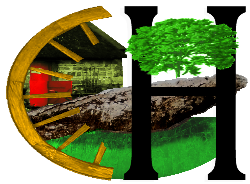
Stauntons Forge, Newtown, Clogher has been rebuilt from a ruin by our local FÁS C.E. Scheme in 1999. The site and ruin were donated by the Staunton Family of Ballyheane. This Forge was one of six working in a 5-mile radius (the others were Belcarra, French Hill, Ballintubber, Carnacon and Ballyglass). The last horse was shod in 1960 by John Staunton of Catford, until its reconstruction when it opened fully operational in 2001.
It contains many original tools, a number of which were donated. Old forges were scoured, resulting in the acquisition of the prized bellows, which can be seen in situ. The bellows was a vital part of the Smiths' equipment, as was his anvil. The anvil is an original piece of equipment. The forge is fairly simply laid out, the fire being set on a raised hearth made from five or six flagstones with the draught for the fire being provided by the large bellows. Charcoal, turf, coke and coal were all used, depending upon local availability.

The cottage is constructed of local stone and features a traditional thatch**.
In times gone by the thatch would be made from either local reeds, which can be seen growing on the edge of Lough Carra, Moorehall, or from straw. Reeds would be soaked in a solution of blue stone* and water to increase their durability.
This thatch is made of Turkish reeds, the reason for this is that they have been proven to have a much greater life span than locally sourced materials, perhaps 5-10 years longer.
Thatched houses were in evidence at the end of the 17th century and were virtually all rectangular in shape. Great attention to detail was exercised and the neat thatch in a beautiful shade of burnished gold added the finishing touch. Geraniums in big black 3-legged pots took pride of place outside the door, whilst creepers clung to the gleaming white washed walls.
The traditional half-door was a common feature having many advantages. It allowed daylight and fresh air to filter into the house whilst keeping hungry hens out and crawling babies in. It served as an armrest for the farmer smoking his ‘baccy’ as he chatted to his neighbours.
Windows and doors were determined by necessity, window openings being very small and few in numbers. Window taxes were levied on numbers and sizes of windows, those who couldn't pay would only have the minimum amount of daylight and fresh air. These unfortunates often developed typhus, this being due to the lack of fresh air and ventilation. This tax became known as the 'Typhus Tax'.
Since its official opening in July 2004 many visitors have been through the Heritage Cottage door.
It has also been the venue for community meetings and social occasions.
* Blue stone = hydrated copper sulphate.
**Thatcher - Dennis Wright, Mayo Abbey, County Mayo.























